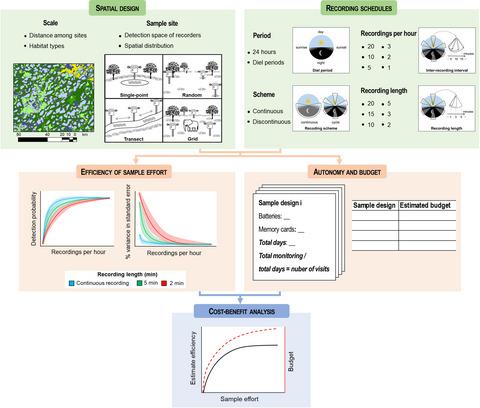当前位置:
X-MOL 学术
›
Remote Sens. Ecol. Conserv.
›
论文详情
Our official English website, www.x-mol.net, welcomes your
feedback! (Note: you will need to create a separate account there.)
A roadmap for survey designs in terrestrial acoustic monitoring
Remote Sensing in Ecology and Conservation ( IF 3.9 ) Pub Date : 2019-11-13 , DOI: 10.1002/rse2.131 Larissa Sayuri Moreira Sugai 1 , Camille Desjonquères 2 , Thiago Sanna Freire Silva 1, 3 , Diego Llusia 2, 4, 5
Remote Sensing in Ecology and Conservation ( IF 3.9 ) Pub Date : 2019-11-13 , DOI: 10.1002/rse2.131 Larissa Sayuri Moreira Sugai 1 , Camille Desjonquères 2 , Thiago Sanna Freire Silva 1, 3 , Diego Llusia 2, 4, 5
Affiliation

|
Passive acoustic monitoring (PAM) is increasingly popular in ecological research and conservation programs, with high‐volume and long‐term data collection provided by automatized acoustic sensors offering unprecedented opportunities for faunal and ecosystem surveys. Practitioners and newcomers interested in PAM can easily find technical specifications for acoustic sensors and microphones, but guidelines on how to plan survey designs are largely scattered over the literature. Here, we (i) review spatial and temporal sampling designs used in passive acoustic monitoring, (ii) provide a synthesis of the crucial aspects of PAM survey design and (iii) propose a workflow to optimize recording autonomy and recording schedules. From 1992 to 2018, most of the 460 studies applying PAM in terrestrial environments have used a single recorder per site, covered broad spatial scales and rotated recorders between sites to optimize sampling effort. Continuous recording of specific diel periods was the main recording procedure used. When recording schedules were applied, a larger number of recordings per hour was generally associated with a smaller recording length. For PAM survey design, we proposed to (i) estimate memory/battery autonomy and associated costs, (ii) assess signal detectability to optimize recording schedules in order to recover maximum biological information and (iii) evaluate cost‐benefit scenarios between sampling effort and budget to address potential biases from a given PAM survey design. Establishing standards for PAM data collection will improve the quality of inferences over the broad scope of PAM research and promote essential standardization for cross‐scale research to understand long‐term biodiversity trends in a changing world.
中文翻译:

地面声学监测中勘测设计的路线图
无源声波监测(PAM)在生态研究和保护计划中越来越受欢迎,自动声波传感器提供的大量和长期数据收集为动物和生态系统调查提供了前所未有的机会。对PAM感兴趣的从业者和新手可以轻松找到声学传感器和麦克风的技术规范,但是有关如何规划调查设计的指导原则在文献上大为分散。在这里,我们(i)回顾了无源声学监测中使用的空间和时间采样设计,(ii)提供了PAM勘测设计关键方面的综合信息,并且(iii)提出了优化录音自主性和录音时间表的工作流程。从1992年到2018年,在陆地环境中应用PAM的460项研究中,大多数在每个站点使用一个记录器,涵盖了广阔的空间规模,并在站点之间旋转了记录器,以优化采样工作。连续记录特定diel周期是所使用的主要记录过程。当应用录像时间表时,每小时的录像数量通常与较小的录像时间有关。对于PAM调查设计,我们建议(i)估计内存/电池的自主性和相关成本,(ii)评估信号可检测性以优化记录时间表,以恢复最大的生物学信息,以及(iii)评估抽样工作与评估之间的成本效益方案。预算以解决特定PAM调查设计中的潜在偏差。
更新日期:2019-11-13
中文翻译:

地面声学监测中勘测设计的路线图
无源声波监测(PAM)在生态研究和保护计划中越来越受欢迎,自动声波传感器提供的大量和长期数据收集为动物和生态系统调查提供了前所未有的机会。对PAM感兴趣的从业者和新手可以轻松找到声学传感器和麦克风的技术规范,但是有关如何规划调查设计的指导原则在文献上大为分散。在这里,我们(i)回顾了无源声学监测中使用的空间和时间采样设计,(ii)提供了PAM勘测设计关键方面的综合信息,并且(iii)提出了优化录音自主性和录音时间表的工作流程。从1992年到2018年,在陆地环境中应用PAM的460项研究中,大多数在每个站点使用一个记录器,涵盖了广阔的空间规模,并在站点之间旋转了记录器,以优化采样工作。连续记录特定diel周期是所使用的主要记录过程。当应用录像时间表时,每小时的录像数量通常与较小的录像时间有关。对于PAM调查设计,我们建议(i)估计内存/电池的自主性和相关成本,(ii)评估信号可检测性以优化记录时间表,以恢复最大的生物学信息,以及(iii)评估抽样工作与评估之间的成本效益方案。预算以解决特定PAM调查设计中的潜在偏差。











































 京公网安备 11010802027423号
京公网安备 11010802027423号